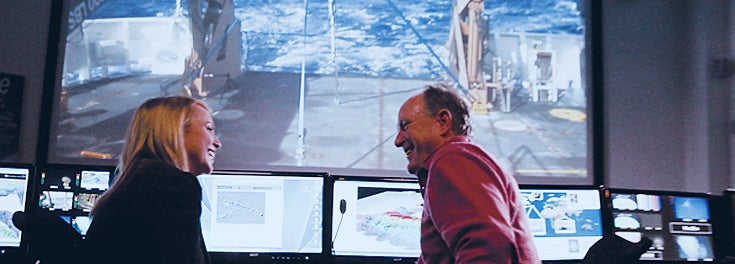
URI Oceanography Professor Robert Ballard, Ph.D. ’75, perhaps best known for discovering the location of the sunken Titanic, had an idea that would take underwater exploration to a whole new level – one that would enable anyone – anywhere – to participate in oceanographic research in real time. His vision of a deep-sea robotic vehicle that could explore everything on the ocean floor – from shipwrecks to artifacts to undersea volcanoes – and send images to observers on land became a reality in June 2009, when URI opened the doors to the Inner Space Center at our Narragansett Bay Campus.
The Inner Space Center uses “telepresence” technology to enable scientists, students, teachers, school children, and, well, anyone to watch underwater exploration as it’s taking place. Imagine. Somewhere in the world’s oceans, scientists aboard the Exploration Vessel Nautilus or the National Oceanic and Atmospheric Administration Ship Okeanos Explorer control remotely operated vehicles (ROVs for short) to explore the ocean’s depths – rocks from the seafloor off the coast of Spain, cargo from sunken ships left behind in the Black Sea, or clues to an ancient city. From the ship, scientists film the ROVs’ journeys in the depths and transmit high-def digital images all the way back to the Inner Space Center at URI, which then posts them to one of several websites – InnerSpaceCenter.org, ExplorationNow.org, NautilusLive.org, and OceanExplorer.noaa.gov – for all the world to see.
From inside the Inner Space Center’s cavernous “mission control facility,” “URI students work around the clock in the center when the ships are at sea, helping to ensure the success of deep-sea explorations half a world away,” said Inner Space Center Director Dwight Coleman. Undergraduates and grad students, primarily in such majors as film/media studies, biology, marine biology, ocean engineering, and even computer science, take part in the explorations in a variety of ways.
From inside the Inner Space Center’s cavernous ‘mission control facility,’ URI students work around the clock in the center when the ships are at sea, helping to ensure the success of deep-sea explorations half a world away.
“They participate in online chats amongst the scientists, log video highlights from the explorations, develop maps and other data sets for web and video production, and ensure the video recordings happen 24/7. Some undergrads work in the production room handling video cameras, audio, and graphics, and graduate students run programs like GIS and Matlab and develop algorithms. Students are the engine of the Inner Space Center,” he said.
One goal of Professor Ballard’s vision – and the Inner Space Center itself – is to create educational programs that encourage students from around the globe to consider a career in underwater archaeology, geology, exploration, or some other area of marine science. During the Nautilus’ four-month deployment in 2010, the NautilusLive.org website had about 232,000 visits from 115 countries and territories. “We have quite a following of citizen scientists,” Dr. Coleman said.
The Inner Space Center partners with dozens of universities, government laboratories, private research institutions, and several museums, aquariums, and science centers. Its telepresence program has partnered with seagoing exploration around the world and worked in collaboration with researchers as far away as Jakarta, Indonesia, and Haifa, Israel. Coming very soon, the Exploration Now program, broadcast from the Inner Space Center studio, will take undersea exploration to thousands of people per day who can tune in to the web feeds or interact with the mission teams from live programming venues around the country.
Soon, three more ships – the University of Washington research vessel R/V Thompson, the private research vessel R/V Falkor (run by Google Executive Chairman Eric Schmidt’s Ocean Institute), and the Woods Hole Oceanographic Institution’s R/V Atlantis – will link up with the Inner Space Center on a regular basis, enabling the public to join oceanographers on even more undersea adventures, broadening the reach of an activity that, until now, was reserved only to a few scientists.
Pictured above: Professor Bob Ballard and 60 Minutes anchor Lara Logan in the mission control room of the Inner Space Center
